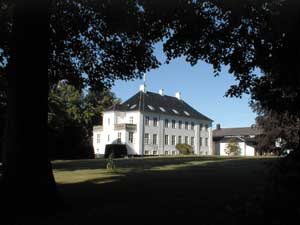
From manor house to folk high school
Krogerup is situated in the middle of the graceful Sealand landscape between forests and fields close to Oresund by the old gunboat harbour. Here history is represented, as the main building is more than just a manor house – even though Karen Blixen described it as recidence suitable only one family.
The Dano-Swedish and Napoleonic Wars
It was on the grounds of Krogerup that vassal Hans Rostgaard lived and fought against the Swedes in the middle of the 17th century. His bibliognostic son Frederik Rostgaard withdrew to Krogerup when he was banished from the absolute Court in 1724 due to accusations of corruption. On the grounds of Krogerup, the noble family van der Maase erected the first known Krogerup building in 1776. Merchant Constantin Brun made a highly profitable living during the Napoleonic Wars, and in 1812 he bought Krogerup for his sons who were farmers. The sons of merchant Brun planted rare trees and added an extra floor to the main building. The Brun family owned Krogerup for 127 years, however, when the last of the Bruns died in 1939, the farm was deep in debt, and none of the heirs wished to inherit the estate.
From Nazi to Communist nest? The Danish state took over Krogerup, and during World War II, the Danish police force established a police academy in the building. When the Nazis took control of the Danish police force in 1944, Hitler’s Danish collaborators, the HIPO Corps, took over and ravaged the building. After the liberation in April 1945, the building was left vacant for some time.
In November 1946, Hal Koch and five enthusiastic teachers had established the school with the arrival of 30 curious students. The students were living in some wodden barracks at great fire risk, but helped to start up the Krogerup Folk High School.
Hal Koch’s school was not welcomed by the folk high school movement and in the national Grundtvigian circles. The school was accused of lacking identity and being a Communist nest. However, the school was neither lacking identity nor housing Communists, but dealt with such ‘odd’ academic elements as European humanism, human rights, democracy and politics. These elements were unfamiliar for the folk high school movement, who, since 1834 had focused on the history of Denmark and the North and the national identity as manifested in the countryside.
At the end the mission succeeded despite much barracking and strong resistance, it is still a wonder, but the solution was most likely – as it has always been for folk high schools – the students. But much has changed since Hal Koch and his colleagues first made an attempt to establish a completely new type of folk high school.
The students brought life to the school and made it sustainable. The beautiful manor house from 1776 – which is the apple of our eye – has been listed, but new buildings have been erected in 1958, 1970, 1988 and 1999.